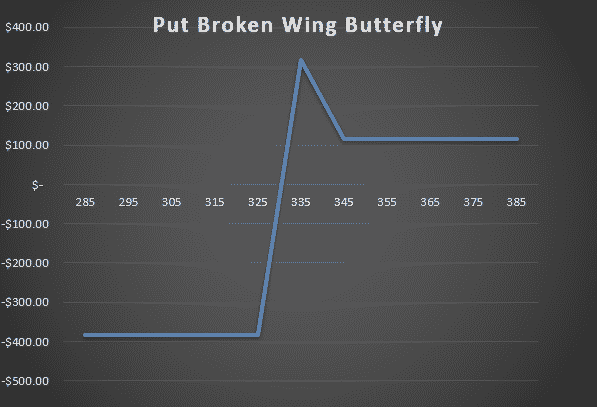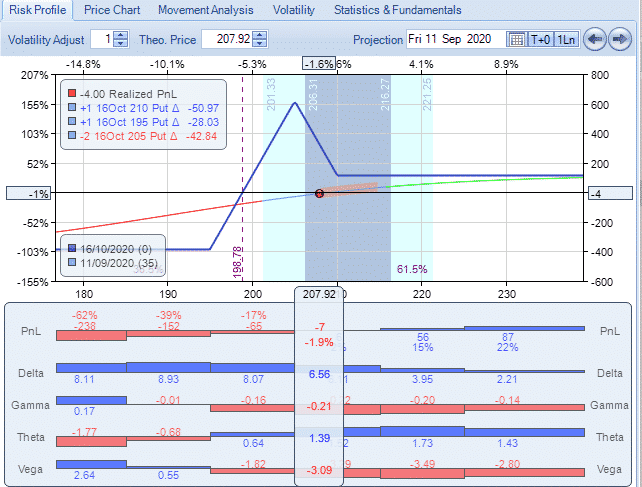

Contents
- Maximum Loss
- Maximum Gain
- Breakeven Price
- Payoff Diagram
- Risk of Early Assignment
- How Volatility Impacts Broken Wing Butterflies
- How Theta Impacts Broken Wing Butterflies
- Other Greeks
- Risks
- Broken Wing Butterflies vs Butterflies
- Trade Management
- Broken Wing Butterfly Example
- Summary
A put broken wing butterfly is a butterfly spread with long put strikes that are not at the same distance from the short put strike.
A broken wing butterfly has more risk on one side of the spread than on the other.
The trade consists of a combination of a bull put spread and a short put spread, both spreads have the same strike in the short puts.
You can also think of it as a butterfly with a “skipped strike”.
The trade is neutral to slightly bullish but can also be set up with a bearish bias.
A broken wing butterfly with puts is usually created buying one in-the-money put, selling two out-of-the-money puts and buying one further out-of-the-money put.
An ideal setup of the trade is to create the broken wing butterfly for a net credit, in this way, there is no risk on the upside.
Put broken wing butterflies are trades that benefit from time decay, the short puts experience faster time decay than the long put legs in the spread (assuming the stock is above the breakeven price).
As long as the underlying asset stays inside the profit zone, the trade should do well.
A put broken wing butterfly is a short volatility trade so tends to benefit from a drop in volatility after the trade is placed.
Here is an example of how a put broken wing butterfly looks and this is the type we will discuss in detail in this article.
Trade Date: October 5th, 2020
Underlying Price: 339.11
Trade Details:
Buy 1 Nov 13th 328 put @ 7.60
Sell 2 Nov 13th 338 puts @ 10.84
Buy 1 Nov 13th 343 put @ 12.92
Net Credit: $116


Maximum Loss
In a put broken wing butterfly, the maximum loss is limited, it is the difference between the width of the wider and narrower put spreads minus the credit received when the trade was initiated.
In the SPY example above, the 328 and 338 legs of the bull put spread are $10 apart, the legs of the 338 and 343 bear put spread are $5 apart.
There is a $10 – $5 =$5 difference between the width of the two spreads.
The trade was created for a credit of $1.16, hence we have a total maximum potential loss of:
![]()
This maximum loss of $384 would happen if the SPY stock drops below $328 at expiration date.
There is no risk on the upside in our broken wing butterfly, the trade will make a net gain of $116 if at expiry SPY trades above $343.
If the trade was created for a debit, the maximum loss would be
Max loss = difference in width of the spreads + net debit.
Maximum Gain
The maximum gain on a broken wing butterfly happens when the stock ends at the strike price of the short puts at expiration.
In this case, the short puts are worthless as well the out-the-money long put.
The higher strike long put will have intrinsic value equal to the difference between the strike price and the ending stock price
In our SPY broken wing butterfly, the trade will make a maximum gain if at expiry SPY closes at $338.
The maximum gain in this scenario would be
Max gain = Upper long put strike price – short strike price + net credit received
Max gain = 5 x 100 + 1.16 = $616.
Usually, the trader chooses to close to trade before expiry to avoid gamma risk.
Breakeven Price
If the broken wing butterfly is established for a credit, there is only one breakeven price at expiration, which is on the downside.
This can be calculated as the strike price of the skipped strike minus the credit we received.
In our SPY trade, the skipped strike is the 333 strike. This is the long put that a regular put butterfly would have.
Therefore, the breakeven price = $333 -$1.16 = $331.84.
If the broken wing butterfly is established for a debit, there is also an upper breakeven price:
Upper breakeven = Strike price long put (ITM) – net debit paid.
Payoff Diagram
Broken wing butterflies have a tent-shaped payoff diagram with the potential for very large profits around the short strike of the puts.
It is important to keep in mind it is very unlikely that the trade would achieve the maximum profit.
The position at expiry if the stock is trading around the short puts strike would suffer heavy fluctuations due to the high gamma of the at-the-money (ATM) puts.
Experienced traders usually close the position before expiry.
A good aim for broken wing butterfly trade is to make a 20-25% return on capital at risk.
In our SPY trade, this would mean to close the trade when it shows a profit of around $90.
Risk of Early Assignment
There is always a risk of early assignment when having a short option position in an individual stock or ETF.
You can mitigate this risk by trading index options, but they are more expensive.
Usually, early assignment only occurs on put options when the short puts are in the money and they have lost their extrinsic value.
To avoid this improbable case, we should close the position before expiration week.
How Volatility Impacts Broken Wing Butterflies
Broken wing butterflies are short vega trades, so generally speaking, they benefit from falling volatility after the trade has been placed.
Looking at the SPY example above, the position starts with a negative vega of 2. This means that for every 1% drop in implied volatility, the trade should gain $2.
The opposite is true if implied volatility rises – the position would lose $2.
You can read more about implied volatility and vega in detail here.
How Theta Impacts Broken Wing Butterflies
Broken wing butterflies are positive Theta trades in that they make money as time passes, with all else being equal.
This is because the short puts suffer faster time decay than the long puts.
This is especially true if the short puts are at at-the-money or close to the trading price of the stock.
This is the ideal setup of the trade if the broken wing butterfly is created for a credit.
In our SPY example, the trade has positive Theta of 1. This means that all else being equal, the trade will gain $1 per day due to time decay.
Other Greeks
Delta
Slightly bearish broken wing butterflies have a small positive delta, close to zero, this is because the width of the bull put spread is shorter than the width to the bear put spread.
The broken wing butterfly can also be placed with a strong bullish bias but in those cases, the position is usually created for a debit.
Our initial SPY position above had a positive delta of 5, the trade makes money if the stock price increases keeping everything else equal.
Gamma
Broken wing butterflies are negative gamma.
Generally, any trade that has a profit tent above the zero line will be negative gamma because they will benefit from stable prices.
In other words, you want the stock to stay relatively flat, small moves in the price of the stock will not affect dramatically the position unless we are close to expiry.
In our SPY example, the position had 0 gamma. The initial impact of gamma on a broken wing butterfly is low, but that can change as time passes and the stock starts to move.
Risks
Broken wing butterflies are limited risk trades if the trade is created for a net credit, all the risk one side and it happens when the stock price drops below the breakeven point. Besides this risk, we can mention the assignment risk and the expiration risk.
Assignment Risk
Although this does not happen often, it can theoretically happen at any point during the trade. The risk is higher when the short puts are in-the-money and has very little time value left.
One way to avoid assignment risk is to trade indexes that are European style and cannot be exercised early. The risk is also very low if the short puts are out-of-the-money.
To reduce assignment risk consider closing your trade if the short puts are close to being in-the-money, particularly if it is close to expiry.
Expiration Risk
Leading into expiration, if the stock is trading just above or just below the short puts, the trader has expiration risk.
The risk here is that the trader might get assigned and then the stock makes an adverse movement before he has had a chance to cover the assignment.
In this case, the best way to avoid this risk is to simply close out the spread before expiry.
While it might be tempting to hold the broken wing butterfly spread and hope that the stock stays above the short puts, there is always a risk and when assignments happen close to expiry, this kind of thing usually ends badly.
Gamma Risk
Close to expiration, the gamma of near at the money options increases, and the price of the short puts will heavily fluctuate even for small moves in the underlying.
One way of protecting the trade against gamma risk is to close the position at least one-week prior expiration.
Broken Wing Butterflies vs Butterflies
The main difference between a broken wing butterfly and regular butterfly is that in the broken wing butterfly the long puts are not located at the same distance from the short positions.
When it is created for a credit, the broken wing butterfly transfers all the risk to the downside.
In a regular butterfly, if the position is created delta neutral, there is equal risk of on the downside and upside.
By moving the out of the money put option further away from the strike price of the underlying, the broken wing butterfly can be created for a credit.
The maximum profit in a broken wing butterfly is higher than a regular butterfly.
There are margin requirements in the broken wing butterfly because of the difference between the width of the two put spreads. A regular butterfly spread does not have any margin requirement.
The maximum loss in a broken win butterfly is higher than in a regular butterfly. The maximum loss in a regular butterfly is the cost of initiating the trade.
Trade Management
As with all trading strategies, it is important to plan out in advance exactly how you are going to manage the trade in any scenario.
What will you do if the stock rallies? What about if it drops? Where will you take profits? Where and how will you adjust? When will you get stopped out?
Let us consider the basics of how to manage broken wing butterflies
Profit Target
It is important to have a profit target. That might be 20% of the capital at risk in the trade.
If you decide to keep the position closer to expiration because the position shows a profit, it is a good idea to move the out of the money put leg closer to the short puts, in this way you mitigate the risk of an unexpected move of the stock.
Stop Loss
Having a stop loss is also important, perhaps more so than the profit target.
With broken wing butterflies, you can set a stop loss based on a percentage of the capital at risk.
Some traders like to set a stop loss at 20% of capital at risk. Others might set it as 30%. Whatever you decide, make sure it is written down and mapped out in your trading plan.
Broken Wing Butterfly Example
Let us go through an example of a broken wing butterfly and see how it progressed throughout the trade.
This trade was on Microsoft (MSFT). Here are the details:
Date: September 11, 2020
Current Price: $207.92
Trade Set Up:
Long 1 October $195 put @ $4.78
Short 2 October $205 puts @ $8.38
Long 1 October $210 put @ $10.80
Premium: $1.18 Net Credit
The total net credit is $1.18 which means the maximum profit is $6.18.
This is calculated as the difference between the width of the spread of the bear and bull puts ($5) plus the premium received $1.18.
This would occur if the stock closed exactly at $205 at expiration. The theoretical maximum loss of the trade is 100 × ($5 -$1.18) = $382 on the downside

By October 8th, MSFT was at 209 and the trade showed a profit of $150.
We decided to close the trade to avoid gamma risk associated with the expiration week.

An important thing to notice here is that the price of MSFT did not change too much during the trade and the stock always closed above the breakeven point.
Positive theta and a drop in vega helped us to close for the position for a profit.
Below is another example from AMZN stock.
Summary
Put broken wing butterflies are neutral to slightly bullish trades that are a very handy tool for any option income trader’s portfolio.
The nice thing about them is that they are low-risk trades that benefit from time decay.
Given that the position contains options across multiple legs, it is important to keep in mind that the bid-ask spreads can be significant and therefore make it difficult to initiate a trade for a decent price.
You should be patient getting it filled.
Broken wing butterflies are generally very slow moving early in the trade.
They are easy to maintain when volatility is low and the stock does not move too much on the downside.
Trade safe!
Disclaimer: The information above is for educational purposes only and should not be treated as investment advice. The strategy presented would not be suitable for investors who are not familiar with exchange traded options. Any readers interested in this strategy should do their own research and seek advice from a licensed financial adviser.











What’s the benefit of opening a BWB with a debit, other than having a negative delta? I see some strategies such as rhino start with a BWB with debit instead of credit, with upside risk. Thanks!
Just changes the risk profile and delta slightly. You can play around with them until you find an exposure level that suits your opinion.
Amazing article! Thank you!
You’re welcome, glad you enjoyed it!
Excellent explanation!